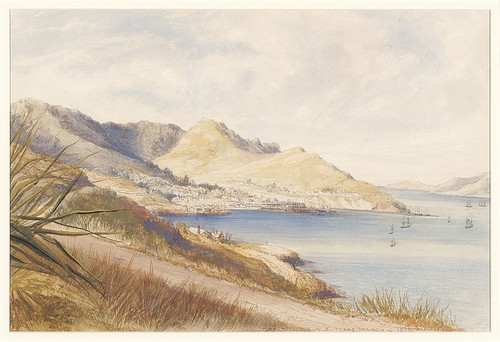B.
Port Lyttelton, N.Z., March 9, 1874, from Nature by Thomas Cane
Collection
This article first appeared in The Press on 27 July 2005
2005 marks the centennial of the death of one of Canterbury's notable Victorian watercolourists and architects, Thomas Cane (1830 - 1905). Cane was born in Brighton, Sussex and prior to his arrival to Canterbury in 1873 he had trained as an architect and quantity surveyor under the firm of Banks and Barry. He was also employed by one of the masters of the Victorian Gothic Revival architectural style, Sir Gilbert Scott, who designed Christchurch's Anglican Cathedral. Cane travelled widely throughout Europe on several occasions visiting France, Germany, Belgium and Holland with the direct purpose of studying medieval architecture. He is likely to have developed his skills as a watercolourist while working as a architect, which would have required producing detailed sketches of building designs.

Thomas Cane Port Lyttelton, N.Z., March 9, 1874 from Nature 1874. Watercolour. Collection of Christchurch Art Gallery Te Puna o Waiwhetū, purchased 2003
Cane immigrated to Canterbury with his wife Emma and their nine children, arriving at Lyttelton on board the Star of India on New Years Eve 1873. Port Lyttelton, N.Z., March 9, 1874, from Nature was completed just weeks after Cane's arrival, and provides an early view of Lyttelton highlighting how dramatically the port has developed since this time.
The scene depicts a small bustling harbour, the breakwater is yet to be completed, and several ships are shown anchored off shore. In the distance the breakwater wharf is seen off Officer's Point while much of the coastline making up Dampier's Bay in the foreground was to be reclaimed during the 1880s. This included the building of a graving dock which opened in 1883 and is still in use. When looking across at the Port from the same vantage point today one is struck with how dramatically the port has developed since the view presented by Cane in 1874. Large areas of reclaimed land have been established on both sides of the port which is today lined with a sea of containers and imported cars, massive cranes and large oil tanks. Lyttelton has become one of New Zealand's major ports and shifts vast volumes of cargo every year. In 2002 a record 1.8 million tonnes of coal were exported through the port.
Although painted ‘from nature' (out-doors directly before the subject) Cane's methodical approach provides a realistic and accurate portrayal of the scene.
His activity as an artist and architect focused predominantly on the Banks Peninsula region. He painted numerous scenes of the Lyttelton and Akaroa Harbours as well as Little River and many of the outlying Bays. The close proximity and accessibility of the Banks Peninsula region to Christchurch has made it an ideal location for many artists based in Christchurch. Cane often visited Akaroa where he would stay with his daughter Elizabeth and son-in-law William Wilkins with whom he established an architectural and engineering practice in Akaroa.
Cane was very much a Canterbury artist who worked exclusively in the watercolour medium and rarely exhibited his work outside the region. He was an active member of the Canterbury Society of Arts and exhibited in the inaugural exhibition in Christchurch in 1881. He regularly contributed work to the Canterbury Society of Arts annual exhibitions till his death in 1905. His work was also included in the Melbourne International Exhibition of 1880 and the Dunedin South Seas Exhibition in 1889 - 1890.
As well as Banks Peninsula, many of Cane's paintings reflect picturesque architectural subjects from his European travels which he continued to produce through to the end of his career. These works in particular show an influence of the English watercolourist Samuel Prout. They sold well and were popular with Christchurch art collectors of the day including James Jamieson. According to family law Cane would dash off a couple of these works in a morning and take them to Fisher's Fine Arts in the afternoon and proceed to Coker's Hotel with the earnings and shout the bar.
Within 16 months of Port Lyttelton, N.Z., March 9, 1874, from Nature being completed Cane had been appointed Canterbury's Provincial Architect and one of his first major designs was the Timeball Station at Lyttelton which was built in 1876. Located on the ridge seen in this painting on the far side of the Port above Officer's Point it is today widely regarded as one of the gems of Canterbury's historic places. With the abolition of New Zealand's Provincial Governments in 1876 Cane established a private practice as an architect with many commissions in the Canterbury region. He went on to design several other significant buildings on Banks Peninsula including The Albion Hotel, Lyttelton (1880), The Grand, Akaroa (1882) and the Somerset Hotel at Duvaucelles (1883). In Christchurch one of his significant designs was the Girls High School on the corner of Hereford Street and Rolleston Ave, (1876) which is now part of the Arts Centre. In 1885 Cane's architectural practice suffered from the effects of a national depression and downturn in work led him to file for bankruptcy. His practice never really recovered from the mid 1880s and his work became largely confined to domestic designs. Cane died in Christchurch on the 16th March 1905.
Peter Vangioni

